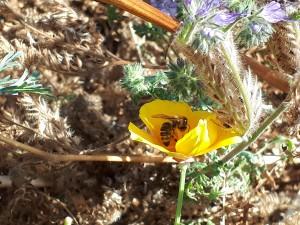Since honey bees typically forage for pollen and nectar within a two- to three-kilometre radius of their hives, honey can provide a localized geochemical “snapshot” of the local environment.

The researchers found that the honey in Vancouver is extremely clean, well below the worldwide average for heavy metals like lead. In fact, an adult would have to consume more than 600 grams, or two cups, of honey every day to exceed tolerable levels.
However, the researchers found that the concentration of elements increased towards the downtown core, where hives are located near areas with heavy traffic, higher urban density and industrial activity such as shipping ports. In other places like Delta, the honey showed elevated levels of manganese, which could be related to agricultural activity and pesticide use in the area.
PCIGR researchers also compared the lead isotopic compositions of the honey to those from other local environmental samples like lichen from around BC, rock from the Garibaldi volcanic belt, sediment from the Fraser River and trees in Stanley Park. They discovered that the lead “fingerprints” of the honey did not match any local, naturally-occurring lead. Rather, the honey from downtown and trees in Stanley Park displayed some striking similarities that pointed to potential manmade sources of lead.
The study reports four years of high-quality, consistent data that serves as a present-day baseline, allowing researchers to monitor small changes in Metro Vancouver’s environment as the city grows and evolves. The PCIGR team will continue to study how honey analysis complements more traditional air and soil sampling techniques and test the efficiency of honey as an environmental biomonitor in other cities around the world.
The research was carried out in partnership with Hives for Humanity, a local non-profit organization that creates opportunities for people in Vancouver’s Downtown Eastside to engage in urban beekeeping.
Nature Sustainability article: view-only version.
UBC Press Release.
PCIGR participated in the BeeHIVE UBC Research Excellence Cluster (2018–2021), which brought community apiarists together with geochemists and bee biologists. Watch additional videos here.